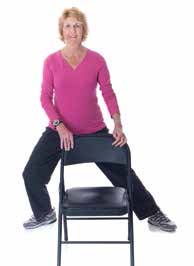
Total hip replacement has become a more common remedy for hip deterioration and pain in recent years. However, most physicians recommend continuing physical therapy afterward. Isn’t healing from the surgery enough? While total hip replacement is no excuse for avoiding activities that help you stay healthy and fit, many people who have had a total hip replacement stop exercising once their required rehabilitation period is complete. In other words, once they can walk normally and climb stairs, they relax—too much.
Many people with total hip replacements favor their nonoperated side, so that the replacement side weakens over time—an undesirable outcome. Plus, without exercise, anyone—with or without total hip replacement—will tend to gain weight, and added weight does a replacement joint no good.
In terms of fitness choices, jogging and basketball are out—people with total hip replacements can’t participate in high-impact sports. That leaves plenty of workouts you can do, every day if you like, including walking, cross-country skiing, swimming and riding a stationary bike. To strengthen the hip muscles, specific exercises are performed standing up and holding the top of a chair, with resistance tubing attached to a closed door or a piece of heavy furniture. Resistive hip flexions, abductions and extensions that move your hip and leg in various directions will make a positive difference in your long-term recovery.
After total hip replacement surgery, rushing too fast to exercise, or even just to perform certain daily activities, isn’t a good idea. Some pointers to remember after the procedure:
• Avoid lifting any significant weight. Even after you have completely healed, never lift or carry anything weighing 60 pounds or more.
• Although you may have some replacement-related pain after three months, it’s possible to have twinges for up to a year. Unless they get worse or more persistent, there is no need to worry.
• Always maintain your hip’s range of motion and strength. If these begin to lag, go back to the exercises prescribed earlier in your recovery. There’s no shame in needing a refresher.
Working out should not stop once you’ve had your hip replaced. With your physician’s input, we will be happy to design a personalized plan that will keep your recovery progressing and help you avoid any problems with your new hip in the future.
